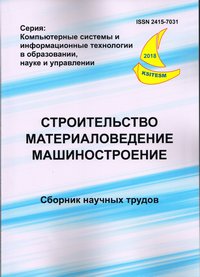Operational reliability management of petroleum reservoirs
DOI:
https://doi.org/10.30838/P.CMM.2415.270818.122.241Keywords:
petroleum reservoir, mathematical model, reliability management, diagnostics, technical condition auditAbstract
Purpose. In the framework of the current system of maintenance and repair of petroleum reservoirs to develop a method for constructing effective schedules for the technical diagnostics of these structures during operation Raising of problem. The content and frequency of technical diagnostics of petroleum reservoirs (RVS) are regulated by the current regulatory documents. However, from the point of view of economic efficiency, the relevant questions with regard to the particular reservoir (or reservoirs park) under the conditions of a particular petroleum depot require further investigation. Such a situation, which has developed in the practice of audits of the technical condition of RVS in service in Ukraine, requires the development of new mathematical models and methods that adequately reflect the essence of the problem of effective management of operational reliability of the facilities in question. Methodology.The article proposes a model of management of operational reliability of RVS based on the minimum of total operating costs, which is formulated in terms of the problem of nonlinear mathematical programming with binary variables. For the numerical realization of this model, a special algorithm based on the principles of constructing "greedy" algorithms was developed, using which economically rational intervals for carrying out technical inspections of the reservoir with a volume of 5000 m3, depending on the required level of operational reliability.. Conclusions. The proposed optimization model for managing the operational reliability of petroleum reservoirs makes it possible to form economically rational strategies for auditing their technical condition over a given service life. This model can be useful in the practice of planning revisions of the technical condition of the RVS both at the initial and at any other stage of the operation process. In addition, this model can be used in reliability problems both for individual reservoir and parks of such reservoirs.References
Budynky i sporudy. Reservuary vertikalni stalevi dlia sberigannia nafty i naftoproduktiv s tyskom nasychenykh pariv ne vyshche 93.3 kPa [Buildings and structures.Reservoirs are vertical steel for storage oils and oil products with pressure of saturated парів not higher 93.3 кПа]. Vidomchi budivelni normy Ukrainy VBN 2.2-58.2-94 [Department building norms of Ukraine VBN 2.2- 58.2-94]. Кyiv, 1994, p. 98 (in Ukrainian).
Dorokhov A.N., Kerzhonitskiy V.A., Mironov A.N. and Shestopalova O.L. Obespechenie nadezhnosti slozhnykh tekhnicheskikh sistem [Ensuring the reliability of complex technical systems]. Saint Petersburg: Lan Publ., 2011, 349 p. (in Russian).
Egorov E.A. Issledovaniye i metody raschetnoy otsenki prochnosti, ustoychivosti i ostatochnogo resursa stalnykh reservuarov, nakhodiashchikhsia v ekspluatstsii [Research and methods of calculation estimation of durability, stability and remaining resource of steel reservoirs being in exploitation]: Sb. nauch. trudov [Coll. scientific. works], 1996, 99 p. (in Russian).
Kapur K. and Lamberson L. Nadezhnost i proektirovaniye sistem [Reliability and designing systems]. Moscow: Mir Publ., 1980, 604p. (in Russian)
Kashtanov V.A. and Medvedev A.I. Teoriya nadezhnosti slozhnykh sistem [Theory of reliability of complex system]. Moscow: Fizmatlit Publ., 2010, 606 p. (in Russian)
Pravyla tekhnichnoi ekspluatatsii reservuariv ta instruktsii po yikh remontu . Dopovnennia ta sminy [Rules of technical exploitation of reservoirs and instruction are on their repair. Addition and changes]. Кyiv, Ukrnaftoprodukt Publ., 1997, p. 297 (in Ukrainian).
Semenets S.N., Nasonova S.S., Vlasenko Yu.E. and Krivenkova L.Yu. Raschetnyye modeli nadezhnosti neftyanykh rezervuarov [Calculation models of reliability of petroleum reservoirs] Visnyk PDABA[Bulletin of Prydniprovs`ka State Academy of Civil Engineering and Architecture], Dnipro, PDABA, 2018, no. 1, pp. 60 - 67. (in Russian)
Downloads
Published
Issue
Section
License
Редакція Видання категорично засуджує прояви плагіату в статтях та вживає всіх можливих заходів для його недопущення. Плагіат розглядається як форма порушення авторських прав і наукової етики.
При виявлені у статті більш ніж 25% запозиченого тексту без відповідних посилань та використання лапок, стаття кваліфікується як така, що містить плагіат. У цьому випадку стаття більше не розглядається редакцією, а автор отримує перше попередження.
Автори, в статтях яких повторно виявлено плагіат, не зможуть публікуватися в усіх журналах Видавництва ДВНЗ «Придніпровська державна академія будівництва та архітектури».
Автори, які публікуються у цьому журналі, погоджуються з наступними умовами:
- Автори залишають за собою право на авторство своєї роботи та передають журналу право першої публікації цієї роботи на умовах ліцензії Creative Commons Attribution License, котра дозволяє іншим особам вільно розповсюджувати опубліковану роботу з обов'язковим посиланням на авторів оригінальної роботи та першу публікацію роботи у цьому журналі.
- Автори мають право укладати самостійні додаткові угоди щодо неексклюзивного розповсюдження роботи у тому вигляді, в якому вона була опублікована цим журналом (наприклад, розміщувати роботу в електронному сховищі установи або публікувати у складі монографії), за умови збереження посилання на першу публікацію роботи у цьому журналі.
- Політика журналу дозволяє і заохочує розміщення авторами в мережі Інтернет (наприклад, у сховищах установ або на особистих веб-сайтах) рукопису роботи, як до подання цього рукопису до редакції, так і під час його редакційного опрацювання, оскільки це сприяє виникненню продуктивної наукової дискусії та позитивно позначається на оперативності та динаміці цитування опублікованої роботи (див. The Effect of Open Access).

